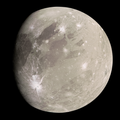Naming
Khensu is named after the Egyptian god Khensu (also known as Khonsu), the youthful god of the Moon, the lunar phases, and travelers. [2] According to Egyptian mythology during the New Kingdom of Egypt, he is the son of the supreme Egyptian god Amun-Ra and his wife Mut whose worship was centered in Thebes, the capital of Ancient Egypt.
According to one myth, he gambled with another moon god named Thoth and lost, which caused Khensu to lose a significant portion of his moonlight, and it explains why the Moon is undergoing phases why and is not as bright as the Sun anymore. The International Astronomical Union (IAU) approved the name for Khensu in 1999. [3]
The IAU ruled that craters and features on Ganymede should be named after deities, heroes or places from Ancient Middle Eastern mythologies, including Egyptian mythology.
Another crater on Ganymede called Khonsu shares the same deity from whom Khensu derives its name (Khonsu being an alternative transliteration of Khensu). [4]
Geography
Khensu is a relatively small crater located entirely within the bright and young surface feature called Uruk Sulcus. [5] It is only 14.2 kilometres (8.8 mi) across [6] and it is a part of the Uruk quadrangle (designated Jg8) of Ganymede. [7]
Little information is know about Khensu. There is no definitely explanation as is why the crater interior is very dark. The dark component may be residual material from the impactor that formed the crater. Another possibility is that the impactor may have punched through the bright surface to reveal a dark layer beneath. [8] Because of its characteristic, Khensu has been classified as a "dark-ray crater" by researchers. [9]
Other craters identified as dark-ray craters include Kittu and Nergal.
The depth of the crater is also not definitely known.
A few kilometers directly to the east of Khensu lies the crater El.
This page is based on this
Wikipedia article Text is available under the
CC BY-SA 4.0 license; additional terms may apply.
Images, videos and audio are available under their respective licenses.

